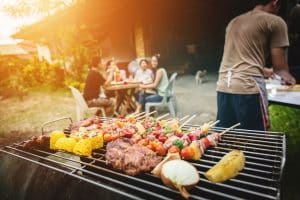Summer Fun Can Lead to Serious Burn Injuries
 Most Americans are taught the basics of fire safety from a young age. Don’t play with matches. Only use the stove with adult supervision. Stop, drop, and roll. Call 9-1-1. Never hide from firefighters. The list goes on and does not stop as we get older. As adults we are reminded to change the batteries in our smoke detectors annually, not to leave the stove unattended while cooking, to have a plan for how to escape a fire in our home or workplace – and to practice it with our family or coworkers. And yet, fires continue to kill and injure a staggering number of people in the United States each year and cause tremendous amounts of property damage.
Most Americans are taught the basics of fire safety from a young age. Don’t play with matches. Only use the stove with adult supervision. Stop, drop, and roll. Call 9-1-1. Never hide from firefighters. The list goes on and does not stop as we get older. As adults we are reminded to change the batteries in our smoke detectors annually, not to leave the stove unattended while cooking, to have a plan for how to escape a fire in our home or workplace – and to practice it with our family or coworkers. And yet, fires continue to kill and injure a staggering number of people in the United States each year and cause tremendous amounts of property damage.
According to the North Dakota Safety Council, there were an estimated 1.4 million fires reported in the U.S. in 2020 based on statistics from the National Fire Protection Association. These fires caused the deaths of 3,500 civilians and caused more than 15,000 injuries to civilians. Not to mention a whopping $21.9 billion in property damage. Approximately 1,800 fire incidents are recorded each year in North Dakota, per the North Dakota Department of Emergency Services in 2020.
Fires can gain momentum and get out of control relatively quickly – especially in rural areas. Fire-related injuries, particularly burns, can be among the most painful, traumatic, and life-altering injuries a person can sustain. In addition to physical scars, burns can also leave people suffering from mental and emotional scars. Car fires, residential or other structure fires, wildfires, and oil field fires can all cause severe burn injuries. This is especially concerning since North Dakota does not have a burn injury center.
Understanding the risks of fire-related injuries and knowing how to prevent fires are crucial to protecting yourself, your loved ones, your neighbors, and your property from fire. The risk of fire and fire-related injuries increases in the spring and fall months when many North Dakotans perform agricultural crop burning, and in the summer months when people spend more time outdoors barbecuing, camping, enjoying fire pits, and celebrating holidays with fireworks.
Burn injuries from barbecues, campfires, and fire pits
Whether you enjoy cooking a hearty meal on your barbecue grill or relaxing around a campfire or fire pit, it is important to know how to stay safe during these activities. For instance, when barbecuing, be sure to adhere to the following safety guidelines:
- Never overfill the grill’s propane tank
- Avoid wearing loose clothing while cooking at a barbecue
- Do not add lighter fluid or other fuel to an already lit fire
Campfires and fire pits also require caution and certain safety measures in order to be enjoyed safely. It is crucial that you carefully plan and monitor every aspect of a recreational fire, including the location and position of the campfire or fire pit, and the weather conditions – particularly the temperature and the amount and direction of the wind. Knowing the correct type of wood and kindling to use to build your fire and the appropriate method to start – and fully extinguish – the fire is also critical. Fires must be completely extinguished, including any smoldering embers. If you fail to adhere to any of these guidelines, the fire can spread to any nearby brush, trees, or buildings that are less than 10 feet from your campfire or fire pit. The fire can even spread to you or other people who are gathered around the fire or nearby. Campfires and fire pits are especially dangerous to children and anyone wearing loose fitting clothing, as they can suffer burns if they get too close to the fire.
Among the many mistakes people can make when starting a campfire or fire pit, the top error is using an accelerant. Substances like gasoline, lighter fluid, or kerosene can cause a fire to quickly grow out of control, resulting in serious burn injuries. Burn injuries fall into three categories:
- First-degree burns. Considered the most minor type of burn, first-degree burns damage only the outer layer of skin, typically causing redness and pain.
- Second-degree burns. Much more serious, second-degree burns may cause scarring if deep enough, as they affect both the outer layer of skin, known as the epidermis, as well as the second layer of skin (or dermis). Second-degree burns can be extremely painful, as they can cause swelling and red, white, or splotchy skin, as well as blisters.
- Third-degree burns. These are the most serious and painful type of burn. Third-degree burns affect the fat layer beneath the skin and can even destroy nerves, causing numbness. Third-degree burns can cause the burned area to turn black, brown, or white, and the skin to take on a leathery appearance.
In addition to burns, campfires and fire pits can also cause lung damage, as people inhale the smoke and ash from the fire. If the wood used in the fire was previously treated with chemicals, it can release toxic gases into the air as it burns. These fumes may cause minor issues like coughing or irritated eyes, but may also cause more serious problems like shortness of breath, fainting, headaches, confusion, or even seizures.
Fireworks can also cause burns and other serious injuries
A Fourth of July celebration without fireworks? For many people, this is not even a possibility. Fireworks are popular at holiday parties such as July 4th celebrations, as well as other gatherings. However, they pose a serious danger to both handlers and bystanders. The U.S. Consumer Product Safety Commission (CPSC) reports that in 2021, fireworks injuries in the U.S. increased 25% since 2006. Roughly 11,500 people were treated in emergency rooms for fireworks injuries that year, with nine people losing their lives to fireworks incidents.
Burn injuries are among the most common injury from fireworks, accounting for 32% of fireworks injuries, per the CPSC. Other severe injuries can occur as well, including the loss of an eye, finger, hand, or other body part. Common fireworks injuries include:
- Amputations
- Blunt-force trauma
- Contusions
- Eye injuries, including some that result in blindness
- Fractures
- Lacerations
- Sprains
As with any fire-related incident, there is a serious risk of fire spreading or igniting other fires. This is true of fireworks as well, as fireworks discharged too close to a home or other structure could hit a building and ignite it. Similarly, the sparks from fireworks can cause fires if they land in dry brush or vegetation. Used fireworks that are left behind in dry grass can also ignite. Either of these scenarios involving dry brush, vegetation, or grass can cause wildfires to start. According to the National Fire Protection Association, fireworks were responsible for “an estimated 12,264 fires in 2021, including 2,082 structure fires, 316 vehicle fires, and 9,866 outside and other fires.”
When you or someone you love suffers a burn
When it comes to barbecues, campfires, fire pits, or fireworks, fun can quickly turn dangerous. In North Dakota, a fire in a rural location can quickly grow out of control, causing more injuries and more damage to property. Fires can also occur on and around North Dakota’s many oil fields or on our roadways when oil and equipment are being transported. Whatever the cause, burn injuries can cause devastating physical, mental, and emotional damage.
If you or a loved one suffered burns or other injuries in a fire that was caused by someone else’s negligence, you may be entitled to compensation. Severe burn injuries – including second- or third-degree burns or burns covering a significant percentage of the body, may require both immediate and ongoing medical care, often including several surgeries. Additionally, you or your loved one may be unable to work, resulting in financial hardship for you and your family – possibly forever. It is important to have an experienced personal injury lawyer on your side who understands the long-term consequences – both medically and financially – that you and your family may face in this situation.
Whether you suffered burns due to a recreational or workplace incident, the personal injury attorneys at Larson Law stand ready to help. From our offices in Minot, Bismarck, and Fargo we fight on behalf of burn victims throughout North Dakota. Give us a call or fill out our contact form today to schedule a free consultation. We handle accident cases on a contingency fee basis.

Mark Larson is a Certified Civil Trial Specialist and Certified Civil Pre-Trial Specialist focusing on personal injury, car accidents, wrongful death, and oil field claims. Since 1979, Larson Law has served the injured throughout North Dakota. Read more about Mark V. Larson.
